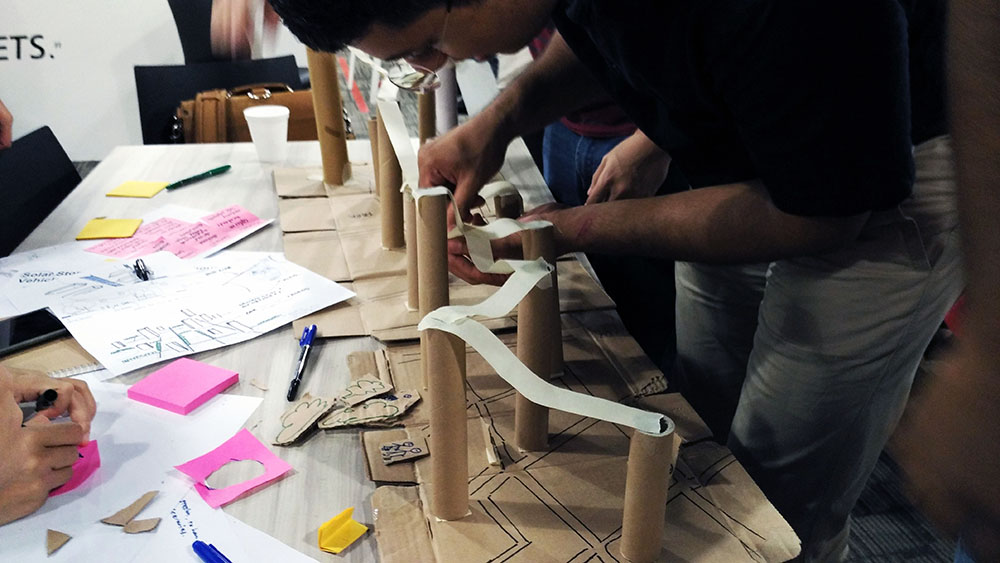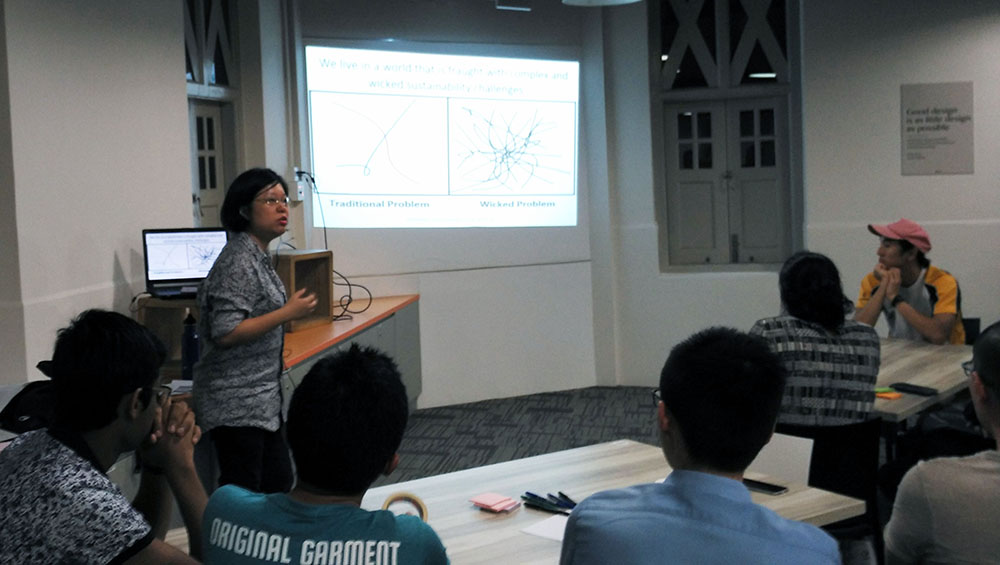
How might the future of mobility look amid the challenges of affordability, climate change and population aging? What are the different transportation needs of a diverse society? Indeed, what journey would we be taking in 2030 and how might we transform the transport experience? These questions were explored at a hands-on workshop on July 21, 2016, the second of a series of workshops co-organised by the Lee Kuan Yew School of Public Policy (LKYSPP) and the Sustainable Living Lab (SL2) to explore the possible futures of Singapore.
Some 50 participants attended the evening workshop held at National Design Centre. Ms Kay Chew Lin from SL2 was the chief facilitator for the evening. This workshop was organised in conjunction with an essay competition on the same topic, for which five prizes of $2,000 each would be awarded.
Before the workshop proper, Chew Lin gave an overview of the transport problems facing many countries and some cutting edge initiatives to address them, such as those aimed at reclaiming city centres for pedestrians and cyclists, and making transport more inclusive to the handicapped.

The rest of the evening was devoted to group work. First, each group of five to six people was given a particular persona and tasked to flesh out the mobility need of this persona. My group worked on creating a narrative for a young sales representative who relied heavily on a car for daily commute and livelihood. Ironically, the majority of our group members were non-car owners, so this taxed our imagination somewhat. Characters given out to other groups included the taxi driver, the weekend cyclist, and the daily cyclist. We were prompted to explore how our characters felt on the road, what would render their commute pleasant or unpleasant, and the kind of changes needed to make transportation work for them.
Having fleshed out these stories, we were asked to mix around to create new groups with a diversity of personas.
In these new groups, we had to envision the future of mobility in Singapore with everyone adopting the perspective of the personas we had created. This envisioning exercise turned out to be neither simple nor straightforward, and was fraught with tensions over competing interests. Which group of commuters ought to be prioritised and on what basis? How far can engineering innovations reshape societal expectations and behaviour? How do we balance the needs of transport infrastructure development with environmental conservation? The discussion within my group got passionate rapidly, and we had to set some ground rules to make sure that everyone’s opinion received a fair airing.
The subsequent segment, and highlight of this hands-on workshop, involved “purposeful making” where each group had to build a prototype of their vision of the future of mobility from materials such as cardboard and mouldable plastic. My group decided that the future of mobility would necessitate the sharing of roads among motorists and cyclists, rather than the constructing of segregated roads. After much discussion (and disagreement), we settled on a smart technology app that would assist all road users in optimising their choice of routes. This app would tap on the network of sensors that the Singapore government is deploying to support the Smart Nation vision. By allocating road users to optimal routes based on their destinations and road usage, the app would help to reduce conflict between different types of road users.
Unfortunately, before my group could even embark on making our prototype, the facilitators threw various wild cards our way. What would happen to our mobility solution in the event of a technical glitch? Could it still work with limited buy-in from the motorists and cyclists? What about the need to curb car ownership in our increasingly congested island city? These awkward questions highlighted the complexity of policy making within the context of a small workshop, and let alone in the real world.
After all the prototypes were finished, the groups took turns to present the prototypes of their mobility solutions. One group identified the redirecting of traffic as the key to the future of transportation. This group created a “hub and home” model which fused the multilevel, multi-purpose transportation interchange and designated carefree zones with residential estates. The prototype also entailed an improved version of the existing park and ride scheme.
One far-out prototype envisioned the popularisation of cable cars and flying foxes or zip lines for congestion-free overland commutes, much to the delight of the workshop participants.
A third group addressed the themes of conservation and spatial justice in the future of transportation. Recent tensions have emerged from the Singapore government’s decision to clear the Bukit Brown cemetery area for an eight-lane road and mass rapid transit station, sparking debates on the place of heritage, environmental concerns and quality of life in the development of the island state.
This group thus proposed the construction of a huge roundabout to redirect traffic around the cemetery. Even though such a policy reversal will probably not materialise, this workshop made me realise that there is still public interest in the topic of Bukit Brown and that the government could strengthen public engagement in future developments to crowdsource innovative solutions.
Chew Lin wrapped up the workshop by inviting us to ponder a number of inconvenient questions which remained little explored. One troubling question was the future livelihood of taxi driver. Taxi driving is for many in Singapore the employment of the last resort since the country does not have any form of national unemployment insurance. In our headlong rush towards a “car-lite” Singapore and to adopt new technologies such as autonomous vehicles, are there any social policies that need to be concurrently redesigned?
This workshop showed me that managing and engaging the public on emotional topics such as natural heritage is just as important as any infrastructure project, and that the social impact of any technological adoption needs to be carefully monitored. After all, public policy needs to be people-driven, especially when it comes to mobility.